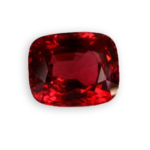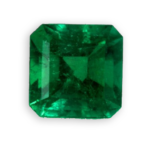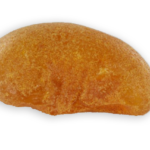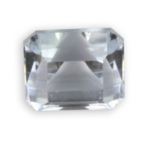
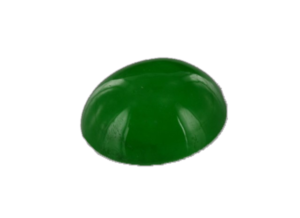
jadeite
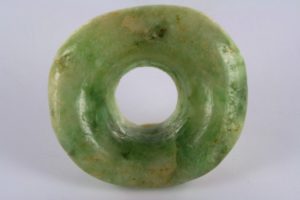
maya earrings from Guatemala
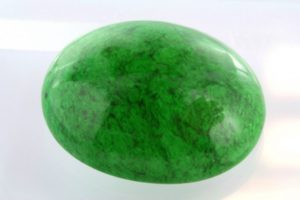
maw – sit – sit variety of jade, from Burma
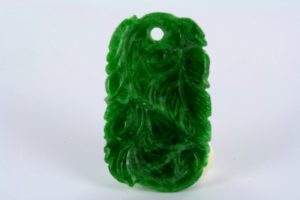
cut jade jadeite from Burma
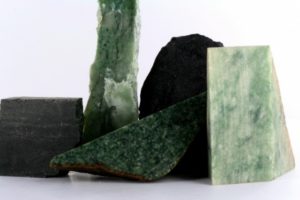
jade jadeite from Guatemala
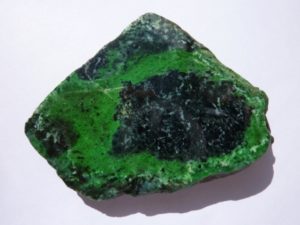
sliced maw-sit-sit jade from Burma
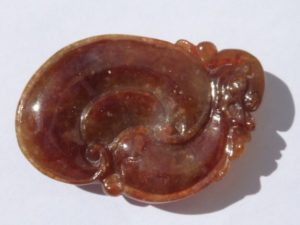
cut brown jade from Burma
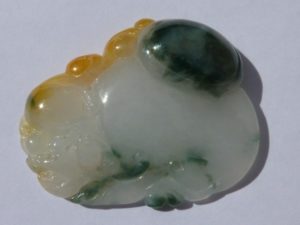
diifferent colors of jade from Burma
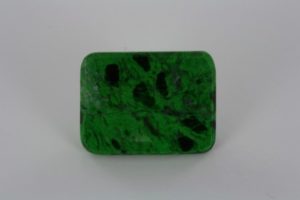
chloromelanite cabochon from Burma
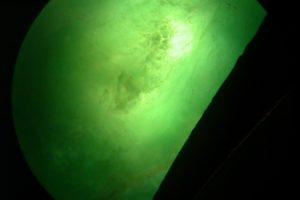
solid like inclusions in an imperial jade
Detailed sheet
jadeite
Its name comes from the term jade. It is the nineteenth century, in 1863, that jadeite was differentiated from nephritis. This is a pyroxene resulting from metamorphism of serpentines high in sodium. Before the nineteenth century both jadeite and nephrite were called with the generic term “ jade “.
Jadeite has appeared in China in the middle of the eighteenth century, from Burma, all the old jades of China prior to this period are nephrites. Jadeite without the presence of the metal ions which color it would be colorless, milky white in fact, but the dark green varieties are colored by iron and the purple ones by manganese. Jadeite “imperial jade” is colored by chromium.
The “magnetite-jade”, is the name for a black jade with magnetite inclusions.
The chloromelanite is the name of a dark green pyroxene,veined black, which is likened to jade.
The kosmochlore, with a composition close to the jadeite, is a sodium and chromium silicate found in a meteorite (in Greek from “ Kosmos” and “chlor” for green), which composes chloromelanite. Its density increases with the concentration of chromium and can reach 3.6.
The Maw-sit-sit, that was discovered in 1963 by Gubelin in Burma in the same deposits of the imperial jade, in north-western Burma, in Kachin state, is actually a rock, a mixture of several minerals such as : chromian jadeite, chromite, ureyite, symplektite, kosmochlore, chromian amphibole and zeolites, mainly natrolite, and its white veins consist of albite in a gangue of serpentine. This is one of the rocks in which the concentration of chromium that gives it its green color is the highest. Sometimes jade-albite is called a “ maw-sit-sit” with veins of white albite.
Throughout Asia, jade is a symbol of luck and health, it is offered for all occasions: births, weddings, birthdays, graduation and even to sign professional contracts.

CHEMICAL CHARACTERISTICS
Na(Al,Fe)[Si2O6]
aluminum and sodium silicate

PHYSICAL CHARACTERISTICS
Main color
green
Other colors
white, brown, grey, yellow, black, pink, purple
practically all the existing colors
Color of streak
white
Luster
vitreous
Hardness
6.5 to 7.0
Density
3.25 to 3.38
Cleavage
none
Fracture
splintery, uneven
very strong but sensitive to sudden shocks for bracelets

OPTICAL PROPERTIES
Transparency
opaque, translucent
some white varieties are practically transparent
Refractive index
1.652 - 1.693
Double refraction
0.015
definite, biaxial (+)
visible double refraction
No
Dispersion
-
Pleochroism
absent
Number of colors
1
lighter or darker shades of green very difficult to observe
Absorption spectrum
691 - 437
for the green varieties 691 and 437

light green jadeite spectrum system

dark green jadeite spectrum system
Fluorescence
very weak
according to origins, and inclusions
Inclusions
many: albite, chromite, kosmochlore ...

CRYSTALS PROPERTIES
micro granular aggregates of micro-pyroxene crystals giving the appearance of sugar on the breaks
crystals system
monoclinic
microcrystalline structure

OTHER INFORMATIONS
Astrological sign
Capricorn, Gemini, Leo, Libra
Chinese astrological sign
Dog, Dragon, Horse, Monkey, Ox, Pig, Rabbit, Rat, Rooster, Sheep, Snake, Tiger

APPROACHING GEMS
Exploited
sites
There are a dozen deposits of jadeite in the world, the largest being located in northern Burma in Kachin state, it is field which produces the bulk of high-quality jadeite present on the international market. Then there is the Sierra de Las Minas, in the valley of the Motogua in Guatemala, where pre-Columbian civilizations found their jade. After being forgotten, this deposit was rediscovered in 1973. The alluvial deposit has only been known for ten years while it delivers a beautiful translucent jade, blue to green. We can then include Japan (Omi-gawa and Kotaki-gawa area Niigata), Kazakhstan, Russia (Ketchpel in the Polar Urals in the Borus chains in Western Sayan), the United States (veins of serpentine of New Idria, California), Italy Punta Rasciassa, in serpentine of Monviso in the western Alps. Jadeite is also found in Brazil, Canada, China, Colombia.
use in jewelry
The most sought jadeite, is the imperial jade emerald green colored, whose color is due to chromium. The purple jadeite or blue one, are also very popular as rare.
It is used in jewelry, cut cabochon, to make rings, necklaces, bracelets … Many objects and pendants are carved in jadeite of all colors and multicolored.
The ring-shaped rigid bracelets, produced in Burma, are very popular amongst Chinese customers.
Jade is the stone of the 12th anniversary or the 26th year of marriage.
Daily care
and precautions
Easy to maintain but sensitive to shocks, especially for bracelets rings. The dyed jadeites are sensitive to solvents and the jeweler should be careful not to expose them to high temperatures.
imitations and
treatments
This is the most imitated kind of jade, because jadeite can reach very high prices. The main treatment consists in bleaching it in a hot acid bath and then soak up with colored resins or not. It can simply be heated to enhance the color or give it a brown color, or tinted without heat treatment.
It is imitated with lead glass (well known to the Chinese), colored or tainted glass , some plastic or porcelain, enamel … doublets, triplets based of jadeite, tinted quartzite, jade improved by artificial dyes.
Note that in the Far East, the jades bleached, dyed and laminated are common in trade. We have synthesized jade plates. The african thick grossular is called “Transvaal jade” but the name is illegal.
Historical
healing properties
In China, Confucius had seen the five great virtues of jade: justice, charity, wisdom, courage, purity, and that’s probably why it was preferred among all the other stones in this country.
It is a matter who has a great value because of its ritual and magic role, earthly incarnation of the cosmic principle Yang, and since at least 4000 BC. the emperor had to absorb some during periods of purification. All of the ritual objects were made of jade and we have very detailed descriptions. The “pi”, a disk pierced in the middle, symbolizes the sky and the hole, the center from which all influences emanated. Jade was also used as an amulet in the funeral rites, supposed to prevent putrefaction of corpses (a “pi” was placed under the body).
Jade, in the broadest sense, symbolizes righteousness, strength, predisposing to calm, tolerance, harmony, peace, ensures honesty, temperance, tolerance. It would boost our emotional development, would make us easy, providing a feeling of satisfaction.
It would extend life. It has been said that jade supposedly would calm nephritic colics, act on the kidney stones and all the affections of the urinary tract … it has to be put on the painful area and degrease it all quarters with calcined bones powder. It was renowned for its healing, and the Emperor Rudolf II bought one piece for 1600 crowns. It was considered at that time, to fight against gout, sciatica, epilepsy, poisonous bites.
historical stones
and related legends
According to legend, the last Aztec emperor, Montezuma II, was pleased in 1521 that “the devils of Spaniards who plundered all the gold that made them crazy”, were not interested in jade, the essential, according to him. This sacred stone of the South Americans came from a more southern region, the Sierra de las Minas, in the current Guatemala, then populated by the Maya. Indeed, the invaders only valued gold and silver, saying that those who wore jade were idolaters who were tortured by the fanatics from Europe. The most famous sample is a dark green mask from Tikal dating from the first century BC.
Venez visitez
notre site web
voillot-joaillier.fr
Lorem ipsum dolor sit amet, consectetur adipiscing elit. Ut elit tellus, luctus nec ullamcorper mattis, pulvinar dapibus leo.Lorem ipsum dolor sit amet, consectetur adipiscing elit. Ut elit tellus, luctus nec ullamcorper mattis, pulvinar dapibus leo consectetur adipiscing elit. Ut elit tellus, luctus nec.

